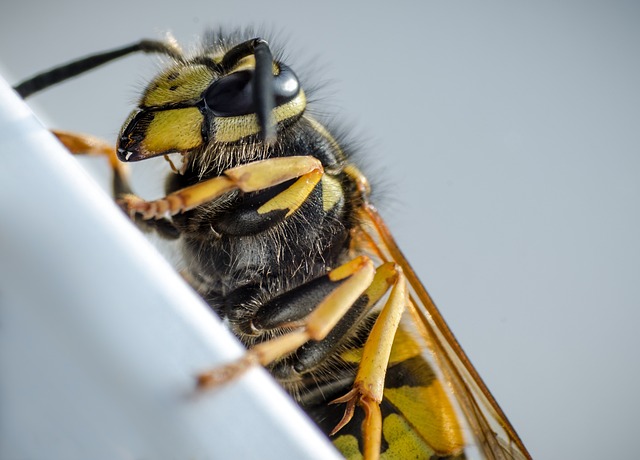
Bees, wasps, and hornets all serve different roles in the South Florida ecosystem. While bees play an essential role in pollination, wasps and hornets can be dangerous to have on your property – and that can make parsing the good stinging insects from the bad difficult. In this blog, we’ll give you some information on all of the different stinging insects in Florida, and help you understand which are practically harmless and which are a real threat.
Types of Stinging Insects Common in South Florida
South Florida is home to a variety of bees, wasps, and hornets. Here are some common species you might encounter:
Bees
- Honeybees: Widely distributed and important pollinators.
- Bumblebees: Known for their large size and distinctive buzzing sound.
Wasps
- Paper Wasps: Recognized for their paper-like nests, these are common and can be aggressive if their nest is disturbed.
- Mud Daubers: Build nests from mud and are generally solitary wasps.
- Yellowjackets: Recognized for their aggressive behavior, yellowjackets build papery nests and can be particularly territorial if their nest is threatened.
Hornets
- Bald-faced Hornets: Recognizable by their black and white coloring, they build large paper nests.
- European Hornets: An introduced species with a large size and distinct brown and yellow coloration.
Below we will give information on each of these insects, talk about the threats that they pose (or do not pose) to people, and answer common questions.
Bees in South Florida
Honey Bees
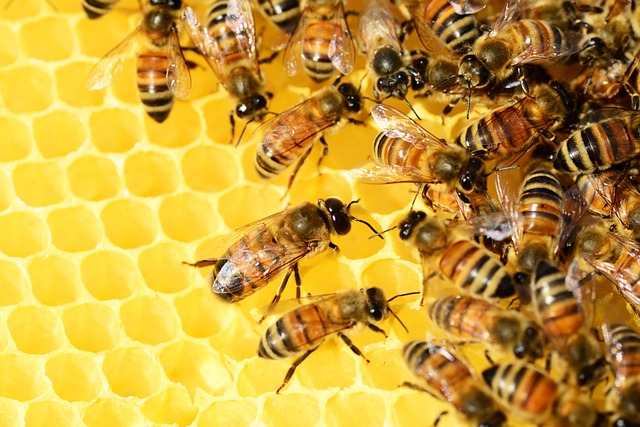
What Do Honey Bees Look Like?
Honey bees have distinctive characteristics that set them apart from other bee species:
Size and Color – Honey bees are generally about 0.5 to 0.6 inches (1.2 to 1.6 cm) in length.
They have a distinct color pattern, featuring golden-yellow to brownish-yellow stripes on their abdomen.
Wings – Honey bees have two pairs of wings that are transparent and veined. The wings are attached to the thorax.
Pollen Baskets – Female worker bees have specialized structures on their hind legs called pollen baskets or corbiculae. These are concave areas surrounded by hairs where they carry pollen back to the hive.
Stinger – Female honey bees (workers and queens) have a stinger at the end of their abdomen. The stinger is barbed and may remain in the skin if the bee stings.
Do Honey Bees Sting?
Honey bees have a barbed stinger, which means that when they CAN sting, and when they sting, the stinger becomes embedded in the victim’s skin. This can result in the bee’s death, as the stinger is attached to the bee’s internal organs. However, honey bees are generally not aggressive and will only sting when they perceive a threat to the hive or themselves. If you come across a honey bee, it’s best to remain calm and avoid swatting at it, as this may provoke defensive behavior.
How Long Do Honey Bees Live?
The lifespan of a honey bee varies depending on its caste within the colony.
Worker honey bees, which are females, have the shortest lifespan among the castes. During the summer, worker bees typically live for a few weeks to a couple of months. Their lives are characterized by intense activity, including foraging for nectar and pollen, nursing the brood, and maintaining the hive. As winter approaches, some worker bees can live for several months as they shift to a more inactive state.
Queens, on the other hand, have a longer lifespan compared to workers. A queen can live for several years, with some reaching up to five years or more. The queen’s primary role is to lay eggs, ensuring the colony’s reproduction and survival.
Drones, the male bees in the colony, have a relatively short lifespan. Drones typically live for a few weeks during the breeding season, and their primary purpose is to mate with a queen from another colony.
What Do Honey Bees Eat?
Honey bees primarily feed on two main types of food: nectar and pollen.
- Nectar – Nectar is a sugary liquid produced by flowers. Honey bees collect nectar using their proboscis (long, tube-like mouthparts) and store it in a special stomach called the honey stomach. Once a foraging honey bee has collected nectar, it returns to the hive and regurgitates the nectar into the mouth of another bee. This process is repeated until the nectar is partially digested and transformed into honey. The honey is then stored in honeycomb cells, and the bees fan their wings to evaporate excess water, creating the thick, sweet substance we know as honey.
- Pollen – Pollen is a protein source for honey bees. Worker bees collect pollen using their specialized structures on their hind legs called pollen baskets. Pollen is mixed with saliva and formed into small pellets, which are then transported back to the hive. Pollen serves as a vital food source, providing essential nutrients for the development of bee larvae and the overall health of the colony.
Danger Level: Low
Bumble Bees
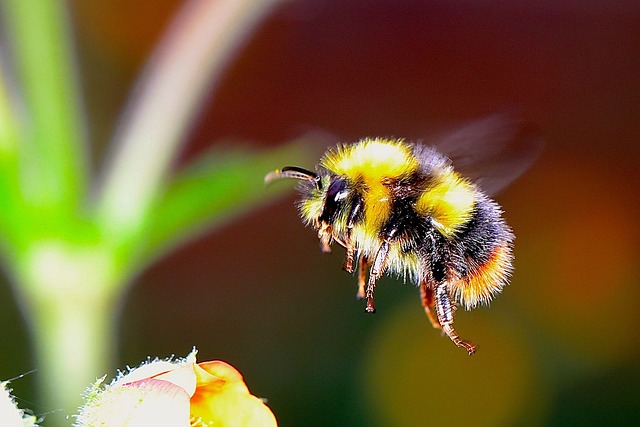
What Do Bumble Bees Look Like?
- Size and Color – Bumble bees are generally larger and more robust than honey bees. They can range in size from about 0.4 to 1.6 inches (1 to 4 cm) in length. The coloration of bumble bees varies, but common colors include black, yellow, orange, and combinations of these colors. Some species may have stripes, spots, or bands.
- Wings – Bumble bees have two pairs of wings that are transparent and veined. The wings are attached to the thorax.
- Stinger – Bumble bees, like honey bees, have a stinger at the end of their abdomen. However, they are generally less aggressive and are less likely to sting unless provoked.
Do Bumble Bees Sting?
Yes, bumble bees are capable of stinging, and like honey bees, they can be defensive when they perceive a threat to their nest or themselves. However, bumble bees are generally less aggressive compared to some other stinging insects, such as wasps or hornets. Bumble bees are not as likely to sting unless they feel their colony or themselves are in immediate danger.
The stinger of a bumble bee is smooth, not barbed like that of a honey bee. This means that a bumble bee can sting repeatedly without injuring itself. Nonetheless, bumble bees are not as prone to stinging as some other bee species, and they are important pollinators that play a crucial role in ecosystems. If you encounter a bumble bee, it’s generally best to remain calm and avoid swatting or threatening it, as this is more likely to provoke defensive behavior.
The Bumble Bee Habitat
Bumble bees are social insects that typically live in colonies. Unlike honey bees, bumble bee colonies are generally smaller and contain only a few hundred individuals. Bumble bee nests are usually found in protected and hidden locations, such as underground burrows or in dense vegetation.
Common nesting sites for bumble bees include:
- Underground Burrows: Many bumble bee species create their nests in abandoned rodent burrows or other pre-existing cavities in the ground. The queen selects a suitable site to establish the colony.
- Vegetation: Some bumble bees build their nests above ground, often hidden in thick vegetation, tall grasses, or abandoned bird nests. The nest may be located on or near the ground.
- Man-Made Structures: Bumble bees can also establish nests in man-made structures, such as old mattresses, insulation, or compost piles.
The Bumble Bee Diet
Bumble bees, like other bee species, primarily feed on nectar and pollen. Their diet plays a vital role in their life cycle and the functioning of their colony.
Danger Level: Very Low
Wasps in South Florida
Paper Wasps
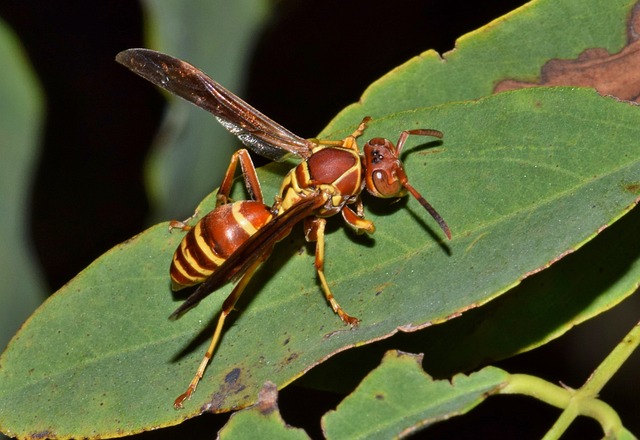
Identifying Paper Wasps
Paper wasps, like many other wasp species, have distinct characteristics that set them apart:
- Size and Color – Paper wasps typically have slender bodies and are about 0.75 to 1.5 inches (1.9 to 3.8 cm) in length. Their coloration can vary, but they often have a combination of black, brown, and yellow markings.
- Body Structure – The body of a paper wasp is divided into three main parts: head, thorax, and abdomen. The head has large compound eyes and chewing mouthparts. The thorax is where the wings and legs are attached. The abdomen is usually slender and may have distinctive markings.
- Wings – Paper wasps have two pairs of membranous wings that are folded longitudinally when at rest.
- Nesting Behavior – Paper wasps are known for building distinctive nests made from paper-like material. The nests are often umbrella-shaped and attached to eaves, branches, or other protected structures. The nests consist of cells where the wasps lay eggs and rear their larvae.
- Long Legs – Paper wasps have relatively long legs that dangle beneath them during flight.
- Aggressive Stance – When threatened, paper wasps may exhibit an aggressive stance, raising their bodies and wings.
Paper Wasps: How Aggressive are They?
Paper wasps can be defensive and may exhibit aggressive behavior, particularly if they perceive a threat to their nest or themselves. While not as inherently aggressive as some other wasp species, such as hornets or yellowjackets, paper wasps can sting, and their stings can be painful. It’s essential to exercise caution and respect when dealing with paper wasps, especially near their nests.
Here are some factors that can influence the aggression of paper wasps:
Proximity to Nest- Paper wasps are generally more defensive and likely to become aggressive if their nest is disturbed or if they feel the need to defend their colony.
Protecting the Colony – Like other social wasps, paper wasps are protective of their colony. If they perceive a threat, they may release alarm pheromones that signal other wasps to become defensive.
Individual Variation – Individual wasps within a colony may vary in temperament. Some individuals may be more aggressive than others.
Seasonal Factors – Paper wasp colonies are typically founded in the spring, and their aggression may peak during this time as the colony becomes established.
The Paper Wasp Diet
- Nectar – Adult paper wasps feed on nectar from flowers. They use their long proboscis (tongue) to extract nectar from the floral structures.
- Pollen – While adult wasps primarily feed on nectar, they also consume small amounts of pollen. Pollen provides protein, which is essential for the development of their larvae.
- Insects and Other Arthropods – Paper wasp larvae are primarily carnivorous, and adult wasps also capture insects and spiders to feed their developing young. They hunt and paralyze these prey items, bringing them back to the nest to be consumed by the larvae.
- Sugary Substances – Apart from nectar, paper wasps are attracted to sugary substances, such as fruit juices, sap, and sweet residues.
Paper wasps do not scavenge on human food like some other wasp species, and they are generally considered beneficial because they play a role in controlling insect populations through predation. It’s important to note that while they are beneficial in terms of pest control, paper wasps can become a nuisance if their nests are located in close proximity to human activity areas. If you encounter a paper wasp nest in an undesirable location, it is recommended to seek professional stinging insect assistance for safe and effective removal.
Getting Rid of Paper Wasps
Removing paper wasps should be approached with caution, especially if their nest is located in a position that poses a threat to human safety – and DIY solutions can be very risky. The safest and most effective way to deal with a paper wasp nest is to hire a professional pest control service. Professionals have the knowledge, experience, and equipment to handle the removal safely.
Danger Level: Medium
Mud Daubers
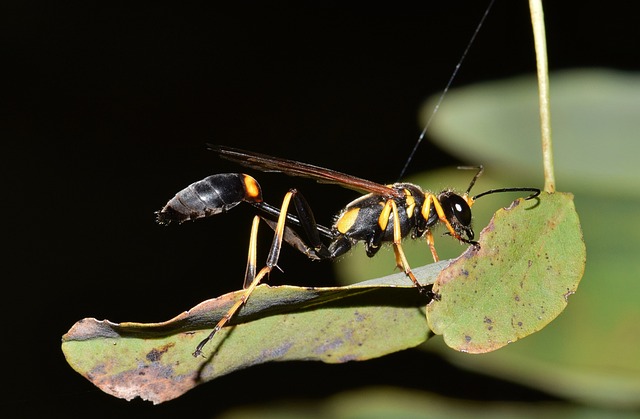
What are Mud Daubers?
Mud daubers, also known as mud wasps or dirt daubers, are solitary wasps belonging to the family Sphecidae. Unlike social wasps, such as paper wasps, mud daubers do not form colonies. Instead, each female constructs and provisions her own nest.
Mud Dauber Behavior
Mud daubers are named for their unique nesting behavior. Females build nests using mud, creating small, tubular structures. The nests are often attached to walls, ceilings, or other structures, and they can sometimes be mistaken for dried mud splatters.
As solitary wasps, meaning that each female builds and tends to her own nest. They do not live in colonies and do not display the aggressive defense behaviors seen in social wasps.
Mud Dauber Appearance
Mud daubers vary in size and color, but they typically have a long, slender body with a narrow waist (petiole) between the thorax and abdomen. Colors can range from black and metallic blue to brown and yellow, depending on the species.
Are Mud Daubers Dangerous?
Mud dauber wasps are generally not considered dangerous to humans. Unlike some social wasps, such as yellowjackets or hornets, mud daubers are solitary wasps and do not form colonies. They are usually not known for being aggressive and are less likely to sting unless directly provoked or handled.
Here are some key points about the potential danger of mud dauber wasps:
- Stinging Behavior – Mud daubers are not as defensive as social wasps, and they are less likely to sting humans. They typically only sting when they feel threatened or if their nests are disturbed.
- Solitary Nature – Since mud daubers are solitary, each female tends to her own nest and does not have a colony to defend. This contributes to their generally docile behavior.
- Nesting Sites – Mud dauber nests, while distinctive and sometimes considered unsightly, are not as problematic as the nests of some social wasps. They are often attached to walls or ceilings and do not pose the same level of danger.
You Found a Mud Dauber Nest on Your Property. What Now?
While mud dauber wasps are not typically considered dangerous, it’s essential to approach any wasp or stinging insect with caution. If you find mud dauber nests in an undesirable location or if their presence poses a concern, it’s recommended to contact a pest control professional for safe and effective removal.
What Do Mud Dauber Nests Look Like?
Mud dauber nests are distinctively tubular structures made of mud, constructed by solitary wasps known as mud daubers. These nests, often attached to walls, ceilings, or eaves, consist of cylindrical cells created by the female wasps collecting and mixing mud with saliva. Unlike some social wasps, mud dauber nests lack an outer envelope, and each cell is open and exposed. The nests have an earthy or brownish color, blending with the mud used in their construction, and typically contain multiple cells arranged in a linear or stacked pattern.
Danger Level: Medium-Low
Yellowjackets
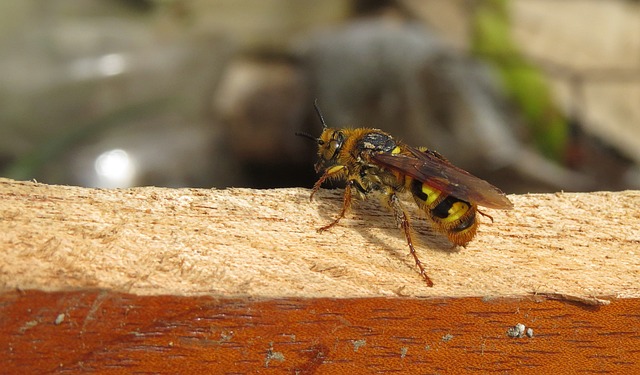
What Do Yellowjackets Look Like?
Yellowjackets are characterized by their black and yellow striped appearance, with a length typically ranging from 0.5 to 0.75 inches. They have a slender body with a distinct waist, large compound eyes, and two pairs of membranous wings that fold longitudinally. Yellowjackets build papery nests, often underground or in enclosed spaces, displaying aggressive behavior when defending their colony. Unlike bees, they possess smooth stingers, enabling them to sting repeatedly. Known for their painful stings, yellowjackets should be approached with caution, especially near their nests, and professional assistance is recommended for safe nest removal.
Yellowjackets vs. Paper Wasps: What’s the Difference?
Yellowjackets and paper wasps share some similarities in appearance, but there are key differences that can help distinguish between the two:
- Coloration – Both yellowjackets and paper wasps have black and yellow markings, but the patterns can vary. Yellowjackets typically have a more distinct pattern with bold, defined bands on their abdomen, resembling a striped pattern. Paper wasps may have a more varied pattern, with some species having smoother transitions between colors.
- Body Shape – Yellowjackets generally have a more robust and stocky body compared to paper wasps. They often appear more stout and aggressive in shape. Paper wasps typically have a longer, slender body, and their legs may appear longer and more slender than those of yellowjackets.
- Nest Location – Yellowjackets commonly build nests underground or in enclosed spaces, such as wall voids, attics, or eaves. Their nests are usually covered with a papery envelope. Paper wasps often build exposed, umbrella-shaped nests that hang from branches, eaves, or other structures.
- Behavior – Yellowjackets are known for their aggressive behavior, especially when defending their nest. They can be more territorial and may exhibit aggressive behavior when disturbed. Paper wasps are generally less aggressive than yellowjackets, and they are more likely to fly away than to engage in defensive behavior unless their nest is threatened.
- Stinger – Both yellowjackets and paper wasps have smooth stingers, allowing them to sting repeatedly. However, yellowjackets are often considered more aggressive and more likely to sting.
Yellowjackets Can Be Aggressive
Yellowjackets are capable of stinging, and they are known for their aggressive behavior, especially when they perceive a threat to their nest. Yellowjackets have smooth stingers, which means they can sting repeatedly without losing their stinger.
Yellowjacket stings can be painful, and some individuals may have an allergic reaction to the venom, which can lead to more severe symptoms. The sting can cause pain, redness, swelling, and, in some cases, allergic reactions such as difficulty breathing, nausea, or anaphylaxis.
It’s important to exercise caution around yellowjackets, especially if you encounter a nest. Avoid provoking or disturbing them, as this can trigger defensive behavior. If you have a yellowjacket nest in or near your home, it is advisable to seek professional assistance for safe and effective removal to minimize the risk of stings.
Danger Level: High
Hornets in South Florida
Bald-Faced Hornets

What Do Bald-Faced Hornets Look Like?
Bald-faced hornets are easily distinguished by their robust black bodies adorned with white or ivory markings on the face, thorax, and abdomen, which contribute to their striking appearance. With a length ranging from 0.5 to 0.75 inches, these hornets have a stout structure and large compound eyes. Their two pairs of membranous wings fold longitudinally when at rest. Recognized for their distinctive nests—large, pear-shaped, and papery—they are commonly found hanging from branches or man-made structures. While their appearance is noteworthy, it’s crucial to approach bald-faced hornets with caution, particularly near their nests, as they are known for aggressive defensive behavior.
Are Bald-Faced Hornets Dangerous?
Bald-faced hornets are known for their aggressive behavior, especially when defending their nest. These hornets are protective of their colony and can be particularly aggressive if they perceive a threat. While the sting of a bald-faced hornet can be painful and cause an allergic reaction in some individuals, fatal incidents are extremely rare. Bald-faced hornets, like many stinging insects, have venom that can cause localized pain, swelling, and redness. However, for most people, the reaction is not severe.
Bald-Faced Hornets are not inherently more dangerous than other stinging insects; their behavior is primarily a response to defending their nest.
The Bald-Faced Hornet Diet & Behavior
Bald-faced hornets are predatory insects, and their diet primarily consists of other insects. They play a crucial role in controlling insect populations, as they capture a variety of insects to feed themselves and provision their developing larvae. The specific types of insects they prey on can include flies, caterpillars, spiders, and other arthropods. Bald-faced hornets are also known to scavenge for sugary substances, such as nectar from flowers and fruit juices. While they may collect nectar for their own energy needs, they predominantly rely on captured insects to feed their larvae.
The foraging range of bald-faced hornets can vary, but generally, they tend to forage within a radius of about 300 to 500 feet from their nest. This range can be influenced by factors such as the availability of food sources, environmental conditions, and the location of their nest. Bald-faced hornets are not typically attracted to human food or picnics like some other stinging insects, such as yellowjackets.
Danger Level: Medium-High
European Hornets
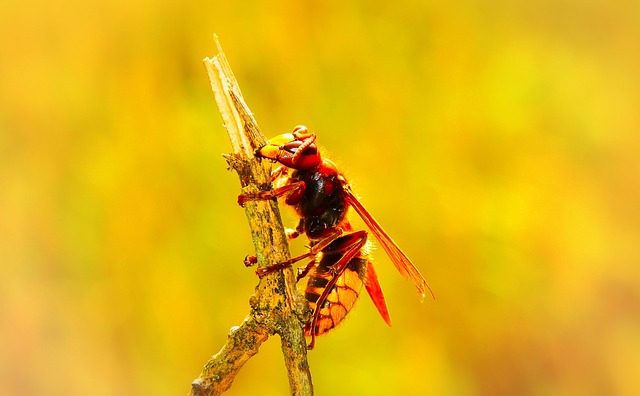
What Are European Hornets?
The European hornet (Vespa crabro) is a large and distinctive species of hornet native to Europe and parts of Asia. However, it has also been introduced to other regions, including Florida. It is believed to have been introduced to the continent, likely in the 1800s. The specific means of introduction is not 100% clear, but there are several theories:
- Accidental Introduction – European hornets might have been accidentally introduced through shipping or transportation of goods, especially wooden materials or plants.
- Hitchhiking on Goods – Hornets or their queens could have hitchhiked on cargo, agricultural products, or other items during international trade.
What Do European Hornets Look Like?
European hornets are among the largest wasps, with queens reaching lengths of about 1.2 inches (3 cm) or more. They have a robust body with a brownish-red or yellowish head and thorax, and the abdomen features brown and yellow bands.
European Hornet Behavior
European hornets build large, paper-like nests, often located in tree hollows, wall voids, attics, or other enclosed spaces. The nests can house colonies with hundreds to thousands of individuals. They are predatory and feed on a variety of insects, including flies, bees, and caterpillars; they also scavenge for sugary substances such as tree sap and nectar. They are also known for their nocturnal activity, meaning they are more active during the evening and night.
An Angry European Hornet Can Be Dangerous
European hornets can be seriously dangerous due to their size, stinging ability, group stinging, and defensive behavior:
- Stinging Ability – Like other hornets and wasps, European hornets have smooth stingers, allowing them to sting repeatedly. Their stings can be painful, and some individuals may experience localized swelling, redness, and itching.
- Defensive Behavior – European hornets can be defensive, especially when their nest is threatened. If the nest is disturbed, the hornets may release a chemical signal that alerts other members of the colony to the perceived threat, leading to a more aggressive response.
- Protecting the Nest – European hornets are protective of their nests, and they may respond aggressively if they perceive any activity near the nesting site as a threat. This can include buzzing around the intruder and stinging if they feel the need to defend their colony.
Danger Level: Very High
What to do About Bees, Wasps, and Hornets
We can see that stinging insects can range from mostly harmless to outright dangerous, but what can you do to mitigate the wasp and hornet threat on your property? At Nozzle Nolen, we have been crafting customized stinging insect control solutions since 1951 – and we can help solve your problem.
Having issues with bees, wasps, or hornets right now? Get in touch with one of our expert team-members and we’ll get your pest problem under control ASAP.




